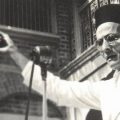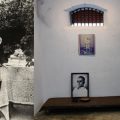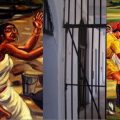Prison Years of Veer Savarkar in Andaman Cellular Jail: An Ignored Saga

This article is an attempt to analyze the period Savarkar served in the Cellular Jail at Port Blair until he was shifted to Ratnagiri Jail in 1921. The Period Veer Savarkar spent at Port Blair strengthened his spirit of revolution and helped him to evolve as a man committed to his cause. Further the period reflect the growth of Savarkar: the culmination of his ideological journey towards ‘Hindutva’. On 4th July 1911, Savarkar was transported to the infamous Cellular Jail in the Andaman and Nicobar Islands to serve 50 years of Imprisonment. He was not considered by the British government as a political prisoner. The events that occurred between 1911-1921 in Savarkar’s life, emphasis upon his experience as a political prisoner, being a member of the lowest rung of prison hierarchy in the Cellular jail played a crucial role in his transformation eventually leading up to the Publication of Hindutva: Who is a Hindu?
The Story of My Transportation for Life is the autobiographical work of Savarkar, recounting the entirety of his stay at Andamans. This is a detailed resource if one wishes to reconstruct Savarkar’s life between the periods of 1911-1923. The Story of My Transportation for Life was first published as a series in the magazine Kesari, in 1926, five years since Savarkar left the Cellular Jail. In 1930, it was first published as a book.
Historical Mapping of Cellular Jail
Originally, in 1788, the British attempted to force settlements on the Islands, but the ongoing clashes with the indigenous tribes foiled their design to establish the full scale operations on the island.
The prison complex was constructed between 1896 to 1906, though the British had been using the Andaman islands as a prison, since 1857: the first war of Independence. Rebels those who survived execution were exiled for life to the Andamans to suppress their zeal of Nationalism. Two hundred freedom fighters were transported to the islands under the custody of the jailer David Barry and Major James Pattison Walker, a military doctor who had been warden of the prison at Agra. The first war of Independence witnessed massive influx of prisoners.
The construction of the structure begun in 1896 and was completed in 1906. The format of the Cellular jail was based on Jeremy Bentham’s idea of the Panopticon. The building had seven wings, at the centre of which a tower served as the intersection and was used by guards to keep watch on the inmates. The wings radiated from the tower in straight lines, much like the spokes of a bicycle wheel.
Bentham initially in a series of letters wrote to a friend in England, while he was visiting Russia in 1787, mentioned the idea that led to the design. The name, “cellular jail”, derived from the solitary cells which prevented any prisoner from communicating with any other. Also, the spokes were so designed such that the face of a cell in a spoke saw the back of cells in another spoke. This way, communication between prisoners was impossible. The same in all solitary confinements.
In essence, Historian Satadru Sen observes in Disciplining Punishment: Colonialism and Convict society in the Andaman Islands, .”..the Cellular jail in Port Blair was designed to function as a machine, stripping prisoners of their humanity — i.e. their criminal selves – in the process of Punishment and reform.”
Solitary confinement was the desired effect, as the British government ensured that political prisoners and revolutionaries were isolated from one another. The Andaman island served as the ideal setting for the government to achieve the same. Authors Cathy Scott-Clark and Adrian Levy in the article titled “Survivors of our hell”; observed: “For the best part of a century, the British Raj sent Indian dissidents and mutineers to a remote island penal colony in an ‘experiment’ that involved torture, medical tests, forced labour and, for many, death.”
The Cellular jail at Port Blair due to its geographical location, extreme isolation and inhuman conditions endured by the prisoners were primarily reserved for those convicts serving lengthiest and severe sentences.
Majority of the prisoners in the Cellular Jail were independence activists. Some inmates were Fazl-e-Haq Khairabadi, Yogendra Shukla, Batukeshwar Dutt, Sachindra Nath Sanyal, Bhai Parmanand, Subodh Roy, Trailokyanath Chakravarty, and many others.
Clarke Anderson recorded extensively on the history of confinement in the Indian Ocean, including two articles emphasizing upon the Cellular jail. In “The Politics of Convict Space: Penal Settlements in Southeast Asia,” Anderson stressing upon the Strategical significance of the Cellular jail location, observed: “Transportation was a punishment that removed offenders from society, isolated them in distant settlements overseas and put them to work. At the same time, colonial officials believed that the journey across the ocean (black water, or Kala Pani) which transportation entailed threatened convicts with loss of caste and hence social exclusion.”
At the time, when Savarkar was serving his tenure at Cellular jail, his elder brother was inmate there. Ganesh Savarkar (known as “Baburao”) find occasional references in Savarkar’s work. From chapter IX, in a particular section, Savarkar recounted in detail, the mental agony, and the physical torment that his brother underwent when forced to work in the Oil- Mill, despite being extremely ill. Savarkar, further added, though conscious of Baburao’s condition, the prison doctor was reluctant to remove him from his labour, as he feared that he may be accused of sympathizing with the inmate. Baburao survived the sentence in Andaman, but couldn’t recover from its horror.
The presence of indigenous tribes in the Andaman Islands who had no relation to the modern world worked as a powerful deterrent. Savarkar mentions these natives in his autobiographical work My Transportation for Life and the description is extremely fitting, and also reflect the government’s tactics to use the narrative of the native tribes to instill fear among prisoners as a precautionary measure and deterrence for escape attempts.
When Savarkar along with other fellow prisoners arrived at Cellular jail for the first time, they met the infamous police Superintendent David Barrie. Savarkar quotes the warnings issued by Barrie:
I would give you one more tip, and it is this “You will be involving yourself in a terrible mess if ever you try to run away from this place. The prison is surrounded on all sides by vast, dense, impenetrable jungles; the cruelest of Aborigines make their abode in them; they are cannibals. If they catch you, they kill you, and make a meal of tender, young bodies like yours; as easily as we may eat cucumbers!”
Inhumane Treatment in the Cellular Jail
At the beginning of the Chapter IX of My Transportation, Savarkar mentioned that life of the political prisoners in the Cellular jail, before him had been difficult, but not unbearable. However, the scenario changed, when a group of nationalists — convicted in the Bengal Bomb case was transported to the Cellular Jail — A High ranking official from Calcutta (who remains anonymous) visited the jail and was disgruntled by way the “Bomb-Makers” were being treated. Savarkar recounts, that the same man signified that political prisoners “…… are the worst prisoners in the world, and they must be treated in this prison that will break their spirit and completely demoralize them.” Sen corroborates the statement in his work: “The nationalist convicts were, for the most part, seen by the jailors as beyond rehabilitation, and as impervious to the mechanism that were typically used in the Andamans to generate and sustain loyalty. As such, with these prisoners, the goals of transportation were isolation and containment, rather than reform and reclamation.”
Political prisoners were allotted to turn the oil mill (as a part of the daily labor). This singular work, as find place in almost every account of the survivors of the Cellular jail, was cruel and inhuman, involved being “yoked like animals to the handle that turned the wheel… twenty turns of the wheel were enough to drain away the strength of the strongest cooly and the worst, brawny badmash. No dacoit past twenty was put on that work. But the political prisoner was fit to do it at any age.”
The severity of working in the Oil- mill is validated by numerous reports, including the works of Barindra Ghosh and many former Prisoners interviewed by the Guardian for an article. The mental agony and physical torment underwent by the political prisoners are hard to describe and many of them worked so hard, that they were physically unable to continue the labor allotted. Sen observed: “…it is clear that the labour to which political prisoners were subjected in the Andamans was intended to function as a form of torture…There was, in such labor, no question of ‘reform,’ and no possibility of rehabilitation. Political prisoners were not expected to actually meet their quota of Oil; those who did were not rewarded….”
In 2001, Authors Cathy Scott-Clark and Adrian Levy wrote an article in the Guardian “Survivors of our hell”; they both uncovered classified official records from the Cellular jail.
One of the infamous story they unearthed was of prisoner Mahavir Singh, interned in the Cellular jail during the 1930s. When he began a hunger strike, as a measure to break the strike, he was forcefully fed through a rubber catheter into the nose. The practice of forcefully feeding, through rubber catheter was commonplace, Singh paid the ultimate price when the catheter pierced his lung “drowning him in milk”.
Scott-Clark and Levy further writes, shockingly “within four years of [of founding the penal colony in 1858] 3,500 out of 8,000 transportees had been killed or had died of fever….” The staggering figure is corroborated by Sen who notes in Disciplining Punishment that near the middle of the 19th Century, the Government acknowledged mortality rate approaching 30% at Cellular jail.
The prisoners were treated in a dehumanizing manner, and they remained subjects of experiments for prison officials and doctors to conduct inhumane experiments and satisfy their sadistic urges. Moreover, virtually, there was no recourse for the convicts; though prisoners were allowed to submit petitions to the government for early release or for improving living conditions, such pleas never saw the rays of light.
Hunger Strikes:- Savarkar in My Transportation for Life, describes in detail, the prisoners dejected with the conditions in the Cellular jail. Moreover, watching their colleague suffer and punished severely, orchestrated work strikes and it seems that Savarkar was often the leader. According to Savarkar, Mr. Barrie declared that “Savarkar was the father of unrest in the Andamans…” Savarkar’s involvement in such work strikes reflect his undying spirit of nationalism and commitment to his causes, even under the most trying circumstances.
Hunger strikes by the inmates in May 1933 caught the attention of the jail authorities. 33 prisoners protested their treatment and sat in hunger strike. Among them were Mahavir Singh, an associate of Bhagat Singh (Lahore conspiracy case), Mohan Kishore Namadas (convicted in Arms Act Case) and Mohit Moitra (also convicted in Arms Act Case). These three died due to force-feeding.
Cellular Jail Library:- Savarkar, in chapter XII reveal his daily life in the prison, the importance of books given to the prisoners. Though, the collection was limited and extremely restricted, Savarkar assert the importance of reading as for augmenting intellectual ability and to strengthen the revolutionary philosophy, to further one’s political agenda. Savarkar’s years of relentless effort and struggle with the prison officials, he and some of his companions were successful to establish a prison library which included works of Swami Vivekananda, Tolstoy (My Religion), Mazzini,Bluntschli, Herbert Spencer, and works in theosophy by Annie Besant — among many others. All this literature helped Savarkar to give concrete shape to his Hindutva philosophy, Savarkar further recounts that owing to his excellent memory, he was able to produce written outlines of many books which he had read previously. The outlines either scribbled on scraps of paper or on the walls of the prison, educated other prisoners, and also motivated Savarkar to continue his work. In one occasion, he describes “a full outline of Spencer’s ‘First Principles’ onto one wall, and “all the definitions of political economy as I had learnt from Mills’ work on the subject” on another. This process of scribbling on the walls of the prison, later, took the shape of early drafts of Hindutva: Who is a Hindu?
Savarkar’s Mercy Petitions:- Savarkar during his tenure as a political prisoner submitted a number of Mercy Petitions for certain concessions in connection with his sentences.
On 30th August, 1911, after a month at the Cellular jail, Savarkar submitted his first petitions. The petition was rejected on 3rd September 1911. This was followed by another petition on 14th November 1913, which was rejected too. In 1917, another mercy petition was submitted by Savarkar, for general amnesty of all political prisoners. The same was rejected again.
On December 1919, there was a royal proclamation by King George V. On 30th march, in lieu of the Royal proclamation, Savarkar submitted his fourth mercy petition to the British government. In the petition, Savarkar noted “So far from believing in the militant school of the Bukanin type, I do not contribute even to the peaceful and philosophical anarchism of a Kuropatkin [sic] or a Tolstoy. And as to my revolutionary tendencies in the past:- it is not only now for the object of sharing the clemency but years before this have I informed of and written to the Government in my petitions (1918, 1914) about my firm intention to abide by the constitution and stand by it as soon as a beginning was made to frame it by Mr Montagu. Since that the Reforms and then the Proclamation have only confirmed me in my views and recently I have publicly avowed my faith in and readiness to stand by the side of orderly and constitutional development.”
The petition was rejected, though the government thought of releasing Ganesh Savarkar.
References:-
1. Charles Higham “Andaman Islands,” in Oxford Encyclopedia of the Modern World (Oxford University Press, 2008).
2. Jeremy Bentham. “Panopticon: or, the Inspection-House.
3. Satadru Sen, Disciplining Punishment: Colonialism and Convict Society in the Andaman Islands (Oxford; New York; New Delhi: Oxford University Press, 2000); 10.
4. Clare Anderson, “The Politics of Convict Space: Penal Settlements in Southeast Asia.” in Isolation: Places and Practices of Exclusion, Ed. Bashford and Strange (2003).
5. Patrick Olivelle, Dharmasutras: The Law codes of Aastamba Gautama, Baudhayana,and Vasistha (Oxford; New York: Oxford University Press, 1999), 168.
6. V.D. Savarkar, “My Transportation for Life,” in Selected Works of Veer Savarkar ( Delhi: Abhishek Publications, 2007), 88.
7. Cathy Scott-Clark and Adrian Levy, “Survivors of Our Hell,” The Guardian 2001.
8. Barindra Kumar Ghosh, The tale of My Exile (Pondicherry: Arya Office, 1922).
9. Ashish Nandy, “ A Disowned Father of the Nation of India: Vinayak Damodar Savarkar and the Demonic and the Seductive in Indian Nationalism,” Inter-Asia Cultural Studies 15, no.1: 98.
Acknowledgements:-
My deepest gratitude to Manoshi mam for providing me with the best platform to publish my work and encouraging me. My deepest gratitude to Bandana Singh for reviewing the articles and sharing her honest feedback.
Featured image courtesy: Google.
Latest posts by manoshi sinha (see all)
- What if Shaikh Paltu had Helped Mangal Panday instead of British? - December 22, 2024
- Shivaleela: Celebration of Shiva in this 21st Century Gurukul - December 22, 2024
- INA Veteran Lt Madhvan Appeals for Installation of Statue of Rash Behari Bose in Delhi - December 22, 2024






